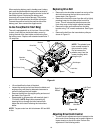
13
Starting Engine
WARNING: Be sure no one other than the
operator is standing near the lawn mower
while starting engine or operating mower.
Never run engine indoors or in enclosed, poorly
ventilated areas. Engine exhaust contains carbon
monoxide, an odorless and deadly gas.
Keep hands, feet, hair and loose clothing away
from any moving parts on engine and lawn mower.
When starting the unit for the first time, face the
mower against a solid object such as a wall, fence,
etc. Start the unit and if it shows any signs of
motion while the drive clutch control is still
disengaged, shut the engine off immediately.
• Make sure that the drive clutch control is adjusted
so the drive belt is as loose as possible.
• Move throttle control lever (if equipped) toward the
“rabbit” position.
• Push the primer three times. Wait two seconds
between each push. In temperatures below 55° F,
prime five times. Do not prime to restart a warm
engine after a short shutdown.
• Standing behind the mower, depress the blade
control handle and hold it against the upper handle.
• Electric Start: Turn the ignition key to the right to
start the engine. Release the key after the engine
starts.
• Recoil Start: Grasp starter handle and pull rope
out slowly until engine reaches the start of
compression cycle (rope will pull slightly harder at
this point). Let the rope rewind slowly. Pull rope with
a rapid, continuous, full arm stroke. Keeping a firm
grip on the starter handle, let the rope rewind
slowly.
Stopping Engine
• Release blade control handle to stop the engine
and the blade.
• Disconnect spark plug wire and move away from
spark plug to prevent accidental starting.
Using Your Lawn Mower
• Do not operate the mower without the mulching
cover, the grass catcher bag, or the discharge
chute properly installed.
• Be sure that the lawn is clear of stones, sticks, wire,
or other objects which could damage lawn mower
or engine. Such objects could be accidently thrown
by the mower in any direction and cause serious
personal injury to the operator and others.
• For best results, do not cut wet grass because it
tends to stick to the underside of the mower,
preventing proper discharge of grass clippings,
poor mulching conditions, and could cause you to
slip and fall. New grass, thick grass, or wet grass
may require a narrower cut.
• For a healthy lawn, always cut off one-third or less
of the total length of the grass. Lawn should be
trimmed in fall as long as there is growth.
• Always operate your mower with the engine in the
full throttle (rabbit) position for the most effective
mulching or bagging of the cut grass.
WARNING: If you strike a foreign object,
stop the engine. Remove spark plug wire
from spark plug, thoroughly inspect the
mower for any damage. Repair the damage
before restarting and operating the mower.
Extensive vibration of the mower during
operation is an indication of damage. The
unit should be promptly inspected and
repaired.
Bagging Grass Clippings
You can use the grass catcher bag to collect clippings
while you are operating the mower. Attach the grass
catcher following instructions on page 10 of this
manual. The grass clippings will automatically collect in
the bag as you run the mower. Operate the mower till
the grass bag is full. Do NOT allow the bag to overfill
with grass clippings.
• Stop the engine completely by releasing the control
handle.
• Make sure that the unit has come to a complete
stop.
• Lift discharge door and pull grass bag up and away
from the mower to dispose of the grass clippings
See Figure 19.
Figure 19
Adjusting Cutting Height
Refer to height adjustments section of this manual on
page 17 for instruction on how to adjust the cutting
height and the handle height.
• For best results in mowing, keep the cutting height
position high until it is determined which height is
best for your lawn.


















